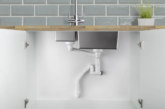Martyn Bridges, Director of Technical Services at Worcester Bosch discusses overcoming the challenges of heat pump installation in the UK’s social housing and the role of the technology moving forward.
It’s fair to say that several years ago there were a number of alarming newspaper headlines and even television coverage regarding the installation of heat pumps in local authority properties — a lot of which was negative.
A sizable proportion of this coverage, if not the majority, was driven by the behaviour of users accustomed to running a gas-fired boiler system. Much the same was happening with households across the country where they were sometimes not instructed or even chose to not follow the instructions on how best to operate their heat pump system. They continued to operate it like their previous boiler systems, intermittently.
Boilers vs. Heat Pumps
Unlike a boiler, a heat pump is at its best when it is circulating low-temperature water around the heating system in a “steady state” mode. It is best run from a weather compensation system and allowed to available to run at all times as dictated by the external weather temperature and the internal room temperature. Because of the low temperature of the heating system water, it is not best suited to be operated intermittently like a boiler.
There were also many residents with prepayment meters, which meant that from time to time, the electric supply to the heat pump would be interrupted. Again though the heat pump was attracting the criticism rather than the real reason.
In general, heat pumps are suitable for almost every property, provided you have the space, reasonable insulation and of course, the correct heating system and radiator sizing to suit the low temperatures at which a heat pump typically operates. We are sure these case numbers were very small, with the majority of people living in homes with heat pumps happy with the comfort levels they achieve.
The cost disparity
Some of our local authority customers are transitioning from gas-fired boilers to heat pumps. However, at present the cost of a boiler when compared to a heat pump, is not in their favour. Typically, more houses can be refurbished with a new boiler than they can with a new heat pump system. For example, the average price of boiler replacement is around £2,500 while the average price of a heat pump installation is £13,000 (according to statistics from the Boiler Upgrade Scheme). If the recently increased £7,500 Boiler Upgrade Scheme grant is considered, then households would be paying around £5,000 – £6,000 for a heat pump installation for a typical UK home.
Transitioning is getting easier
Of course, it can also be a challenge to install and add the equipment a heat pump requires for long-standing tenants, many of whom will have reached a stage whereby their homes are just how they like them. It is a situation that can lead to some difficult conversations but generally, the result of a heat pump running their heating system is mostly positive.
What’s more, as we progress and transition over the coming years from natural gas boilers to heat pump systems, our experience and ability to inform householders on how to correctly run a heat pump system, in addition to improvements in specification and installation will only increase with time.
It’s these reasons that make us confident that heat pump technology and its role in heating local authority properties will only grow in the future as the years progress.










